
The Best AI Tools for Conducting Literature Reviews
Literature reviews can be time-consuming, but AI tools make them faster and more efficient. Whether you're a student, academic, or researcher, these tools help with tasks like finding studies, summarizing papers, and managing citations.
Here are seven top AI tools for literature reviews:
- Sourcely: Advanced search, automated summarization, and citation management.
- Consensus: Evidence-based answers in fields like medicine and economics.
- Research Rabbit: Visualizes connections between studies and authors.
- ChatPDF: AI-powered Q&A for academic papers.
- Scopus: Vast academic database with research tracking.
- Iris.ai: Cross-disciplinary search and summarization.
- Scholarcy: Breaks down complex papers into concise summaries.
Quick Comparison
| Tool | Key Features | Best For |
|---|---|---|
| Sourcely | Smart search, auto-citations, summaries | Quick access to credible sources |
| Consensus | Evidence-based answers, topic categorization | Validating findings in specialized fields |
| Research Rabbit | Visual research mapping, co-authorship tracking | Exploring research connections |
| ChatPDF | Conversational document analysis | Quickly understanding individual papers |
| Scopus | Research tracking, impact analysis | Comprehensive academic database searches |
| Iris.ai | Cross-disciplinary connections | Interdisciplinary research |
| Scholarcy | Automated summaries, reference extraction | Simplifying dense academic content |
Each tool has unique strengths - choose based on your research needs. For quick overviews, try ChatPDF or Scholarcy. For finding connections, use Research Rabbit or Iris.ai. Need evidence-based summaries? Go with Consensus.
Best AI tool for Literature Review
1. Sourcely
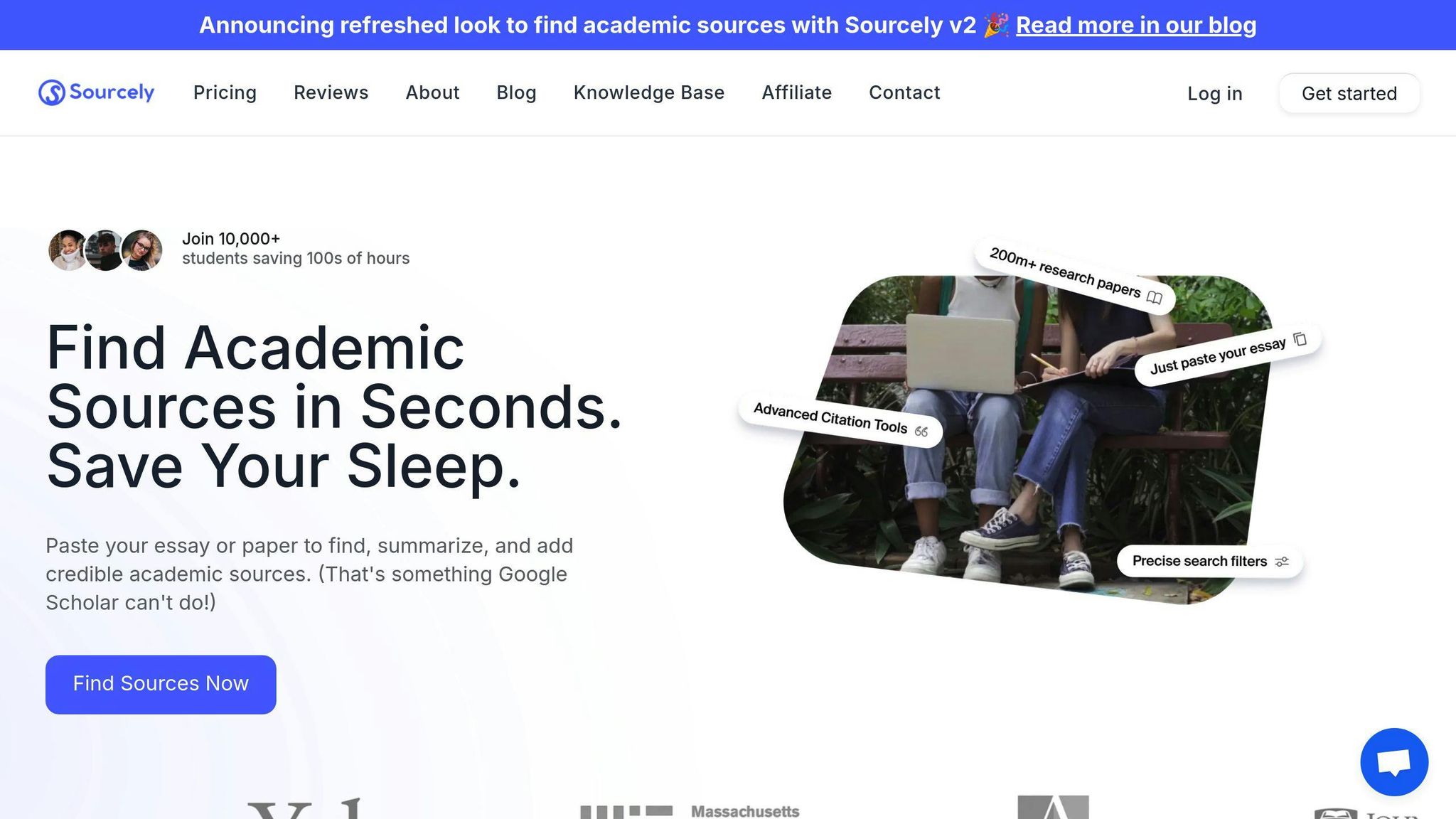
Sourcely combines advanced search tools, smart organization features, and automated summarization to tackle the challenges researchers face during literature reviews.
Search Features
Sourcely’s context-aware search goes beyond basic keyword matching. Its AI understands the intent behind your research, helping you uncover studies that might otherwise slip through the cracks. You can refine results with filters like publication date, author credentials, and research methods, cutting through millions of academic sources to find what matters most.
Managing Citations
Citations are a breeze with Sourcely. The platform supports multiple citation formats and automatically generates them as you gather sources. This automation boosts citation accuracy by 25% compared to manual efforts.
Organizing and Analyzing Sources
Sourcely helps you stay organized with custom collections and smart recommendations that identify gaps in your literature review. Its AI-powered summarization tool condenses lengthy papers into key points, reducing your initial review time by 30%. Plus, it integrates with major academic databases and citation tools, giving you a streamlined workspace for all your research needs.
While Sourcely focuses on automating the research process, tools like Consensus specialize in providing evidence-based answers to targeted questions.
2. Consensus
Consensus is an AI-powered search engine that provides evidence-based answers across six academic fields: economics, sleep, social policy, medicine, mental health, and health supplements.
Search Capabilities
With advanced algorithms, Consensus goes beyond simple keyword searches. It understands the context and details of academic research, delivering direct, evidence-supported answers to specific questions. This approach saves time by quickly identifying crucial papers relevant to your query.
Citation Management
Consensus works seamlessly with popular reference management tools, supporting multiple citation styles like APA, MLA, and Chicago. It auto-generates and formats citations, reducing errors and ensuring accuracy throughout your research.
Source Organization
The platform categorizes sources by themes, connects related studies, tracks evidence reliability, and lets users add custom notes. This structure helps researchers spot patterns and stay on top of their literature review process.
Summarization Features
Consensus uses AI to break down complex academic papers into key takeaways and methodologies. Researchers report a 30% faster completion time for literature reviews, all while retaining essential insights from the original studies.
| Core Feature Area | Key Benefits |
|---|---|
| Question-Based Search | Delivers direct, evidence-supported answers |
| Evidence Strength | Highlights scholarly consensus |
| Field Coverage | Focuses on six academic domains |
| Paper Integration | Automatically links related findings |
3. Research Rabbit
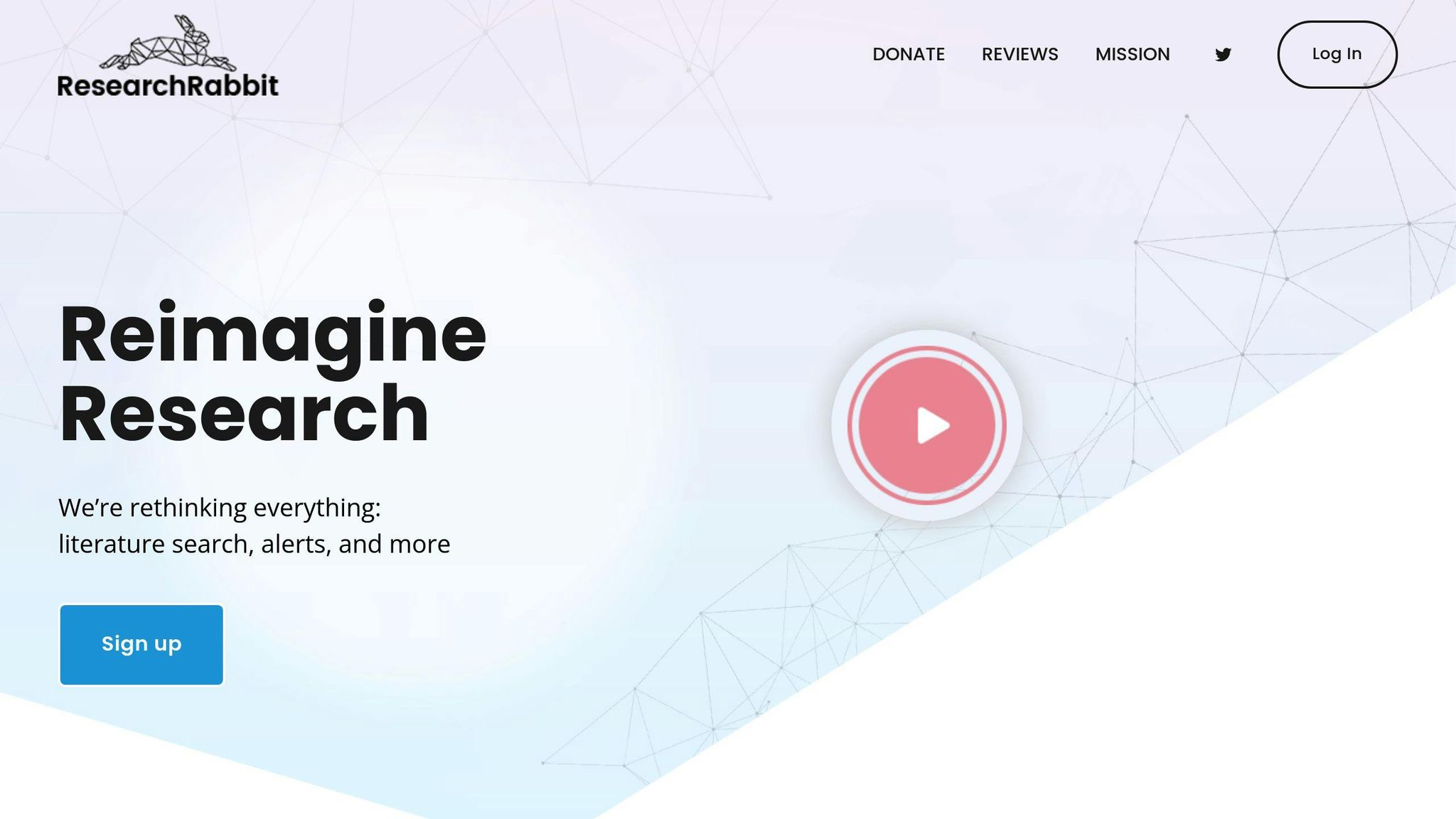
Research Rabbit is an AI-powered tool designed to transform how researchers find and organize academic literature. Its network-based approach offers a fresh way to explore and understand research connections.
Search Capabilities
Research Rabbit uses advanced AI to adapt to your research interests. It provides tailored recommendations and uncovers links between academic works that traditional search methods often overlook.
Citation Management
This tool goes beyond standard citation management by visualizing citation relationships and co-authorship networks. These visual maps make it easier to trace the influence of key studies and understand their academic impact .
Source Organization
Research Rabbit organizes academic papers into thematic collections and visually maps connections between studies and authors. It also tracks co-authorship patterns, helping users pinpoint leading researchers or groups in their field.
| Feature | Function |
|---|---|
| Collections | Group papers by research themes |
| Visual Research Mapping | Show connections between papers and authors |
| Co-authorship Tracking | Highlight research collaborations |
| AI-driven Grouping | Automatically organize by research focus |
Summarization Features
While Research Rabbit doesn’t summarize individual papers, its network visualizations provide a broad overview of research areas. This helps users quickly spot key studies and trends, streamlining the literature review process .
To get the most out of Research Rabbit, update your collections regularly and dive into its visual tools to explore various research areas. By focusing on the relationships between studies, it offers a perspective that complements traditional review methods.
Although Research Rabbit specializes in mapping academic connections, tools like ChatPDF provide a more interactive way to dive into individual papers.
4. ChatPDF
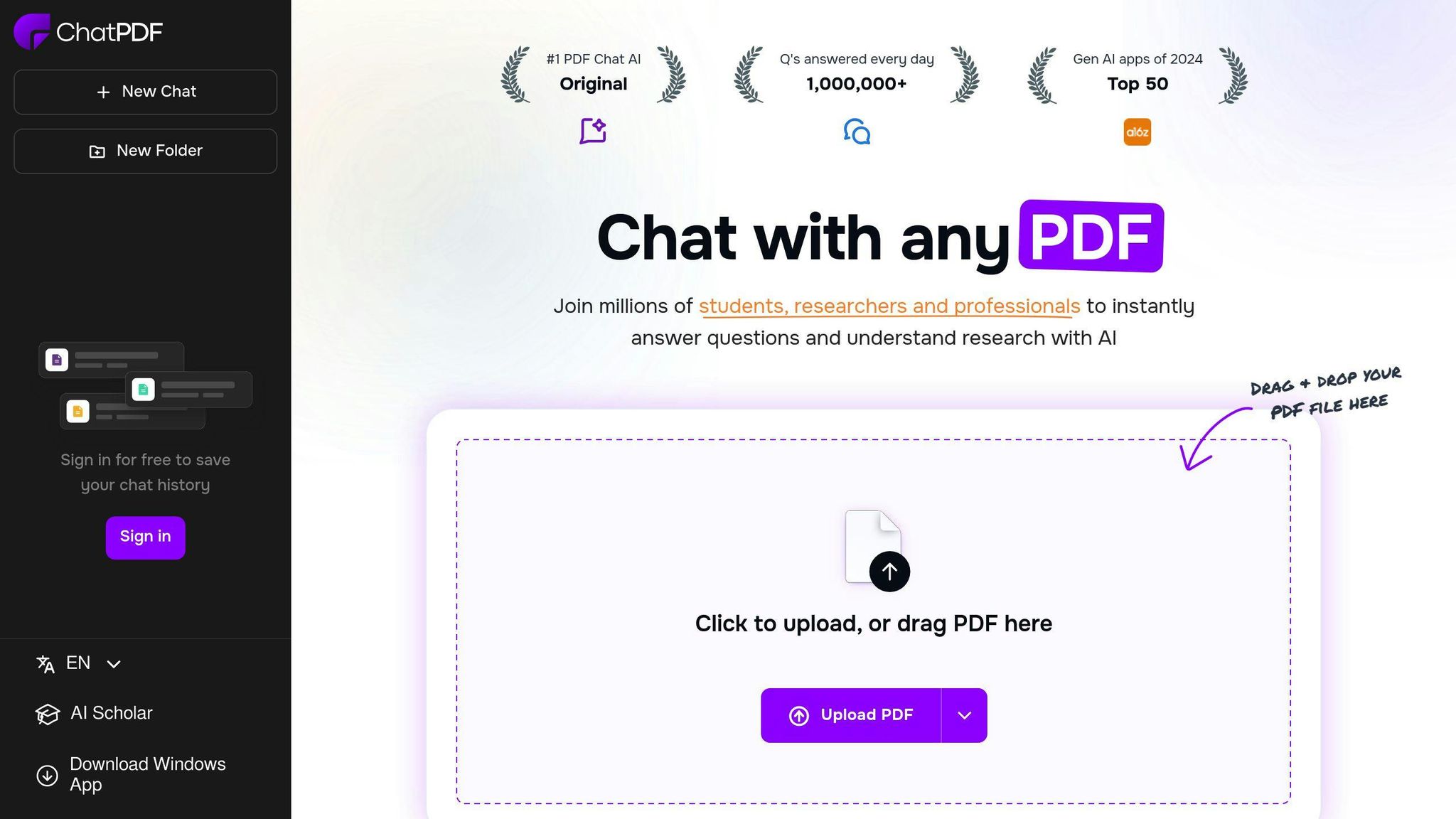
ChatPDF changes the way researchers engage with academic papers by introducing an AI-driven conversational tool for document analysis. It simplifies the process of extracting and understanding information from dense scholarly articles.
Search Capabilities
With ChatPDF, researchers can ask questions in plain language and get quick, accurate answers directly from the document. This conversational approach makes it easier to locate specific details within complex academic texts.
Citation Management
One limitation of ChatPDF is its lack of built-in citation management. To create a complete research workflow, users often combine it with other citation tools.
Source Organization
ChatPDF focuses on working with individual documents rather than managing a collection of sources. For broader organization, researchers often turn to tools like Research Rabbit or Scopus to complement ChatPDF’s capabilities .
| Feature | Capability |
|---|---|
| Document Analysis | AI-powered conversational interaction |
| Information Extraction | Direct question-answering from PDFs |
| Processing Speed | Instant answers |
| Integration | Works with other research tools |
Summarization Features
ChatPDF is particularly helpful for summarizing dense academic papers. Its AI generates clear and concise summaries, highlighting key findings and methodologies . This feature is especially useful for researchers handling multiple papers during extensive literature reviews, allowing for quicker understanding and more focused analysis.
sbb-itb-f7d34da
5. Scopus
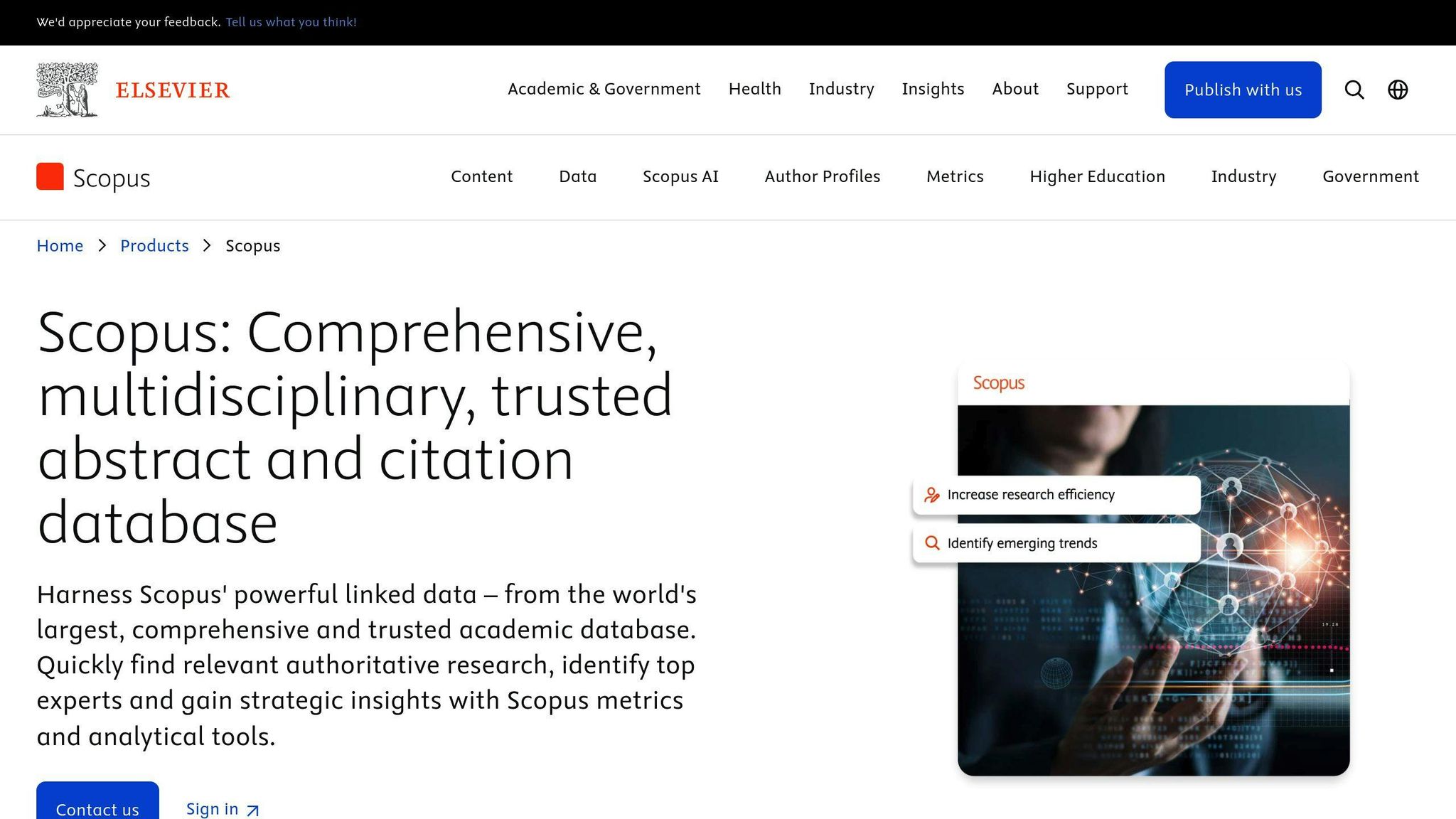
Scopus is a well-known academic database that blends traditional research tools with modern analytics. It plays a key role in literature reviews by combining conventional methods with AI-powered efficiency. With its vast collection of indexed content, Scopus is a go-to resource for academic research.
Search Capabilities
Scopus provides advanced, cross-disciplinary search tools to help researchers locate relevant studies. Its filters allow users to narrow down results, making it easier to focus on essential literature. These tools are also great for spotting research trends and finding connections across different fields.
Citation Management
The citation tracking system in Scopus offers a clear way to visualize how research evolves over time. This feature helps users pinpoint influential studies and understand their impact across disciplines. Key uses include:
- Identifying key papers in a specific field
- Understanding the progression of research over time
- Monitoring the influence of published work
Source Organization
Scopus stands out for its ability to organize large volumes of research. It helps researchers map out trends and find gaps in existing studies. Some of its organizational features include:
| Feature | Purpose |
|---|---|
| Research Tracking | Monitor developments in specific fields |
| Impact Analysis | Evaluate the influence of publications |
| Literature Mapping | Visualize connections across a field |
| Research Gap Analysis | Spot areas lacking sufficient research |
Summarization Features
Although Scopus doesn’t include built-in AI summarization tools, it serves as a solid starting point for literature reviews. Researchers often rely on Scopus for finding and organizing sources, then pair it with other platforms for deeper content analysis.
While Scopus is excellent for database searches and citation tracking, platforms like Iris.ai use AI to add more context and refine research discovery.
6. Iris.ai
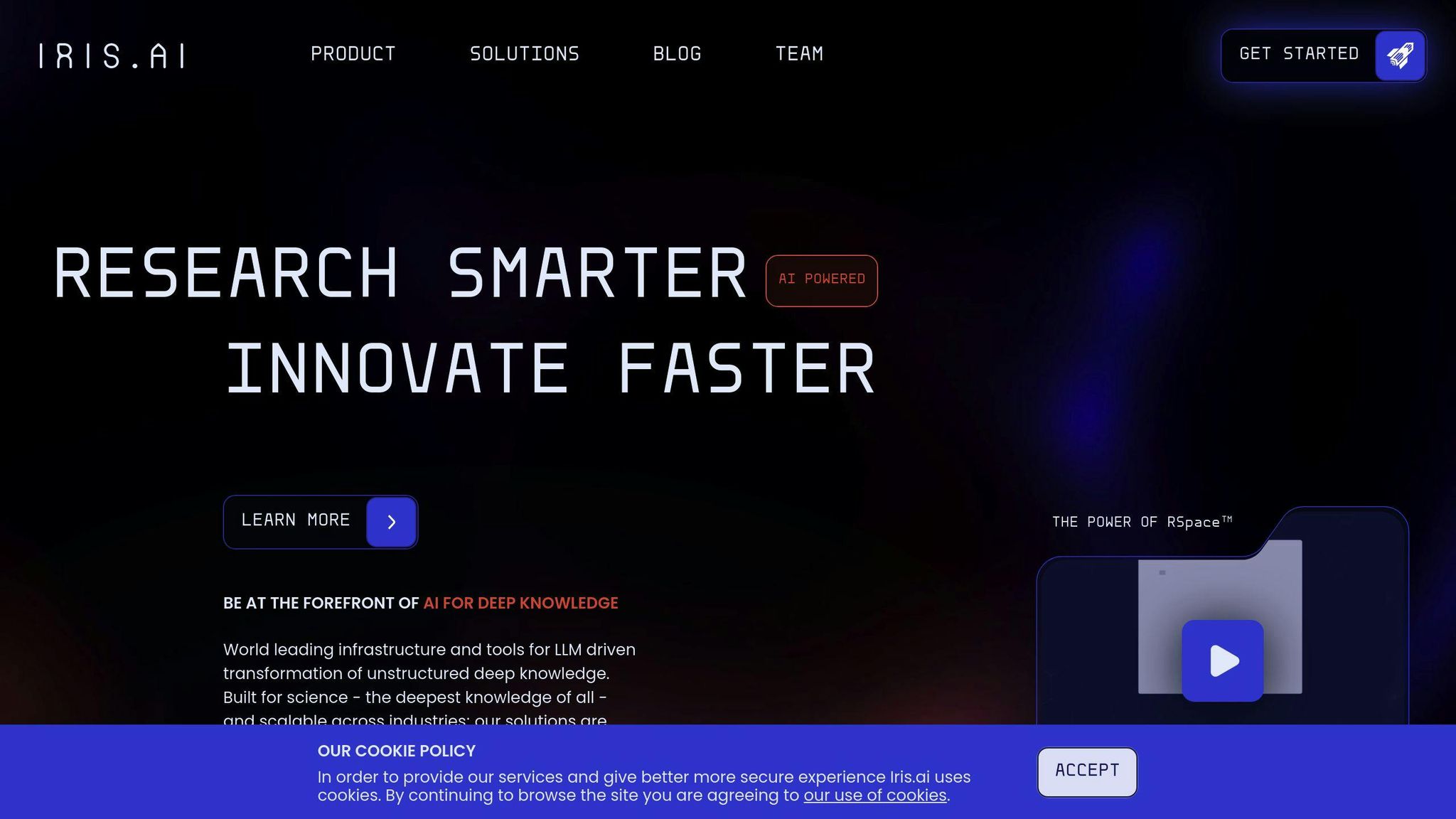
Iris.ai uses AI to streamline literature reviews by finding links between research areas and offering insights into topics that span multiple disciplines.
Search Capabilities
Iris.ai stands out in interdisciplinary research by understanding queries in context and identifying connections across various fields. Its smart search system bridges the gap between disciplines, making it ideal for projects involving multiple research areas.
Citation Management
Although Iris.ai doesn't manage citations directly, it works well with existing citation tools through integrations. Its focus is on discovering and analyzing content, offering features like:
| Integration Aspect | Advantage |
|---|---|
| Export Functionality | Simplifies transferring papers to citation tools |
| Source Tracking | Ensures clear records of paper origins |
| Reference Organization | Structures sources in a logical manner |
| Cross-referencing | Highlights connections between different papers |
Source Organization
With AI-driven categorization, Iris.ai helps researchers handle large collections of interdisciplinary literature. Its automated system groups related papers and identifies meaningful links between them.
Summarization Features
Iris.ai boosts research efficiency through its summarization tools, which include:
| Feature | Purpose |
|---|---|
| Literature Mapping | Provides a visual overview of research connections |
| Content Synthesis | Automatically highlights key findings |
| Thematic Clustering | Groups similar concepts and pinpoints major themes |
These tools extract essential findings and methodologies, making early-stage literature reviews quicker and easier to navigate.
"Iris.ai's ability to enhance productivity during the literature review phase by retrieving and summarizing relevant papers makes it a valuable tool for researchers".
7. Scholarcy
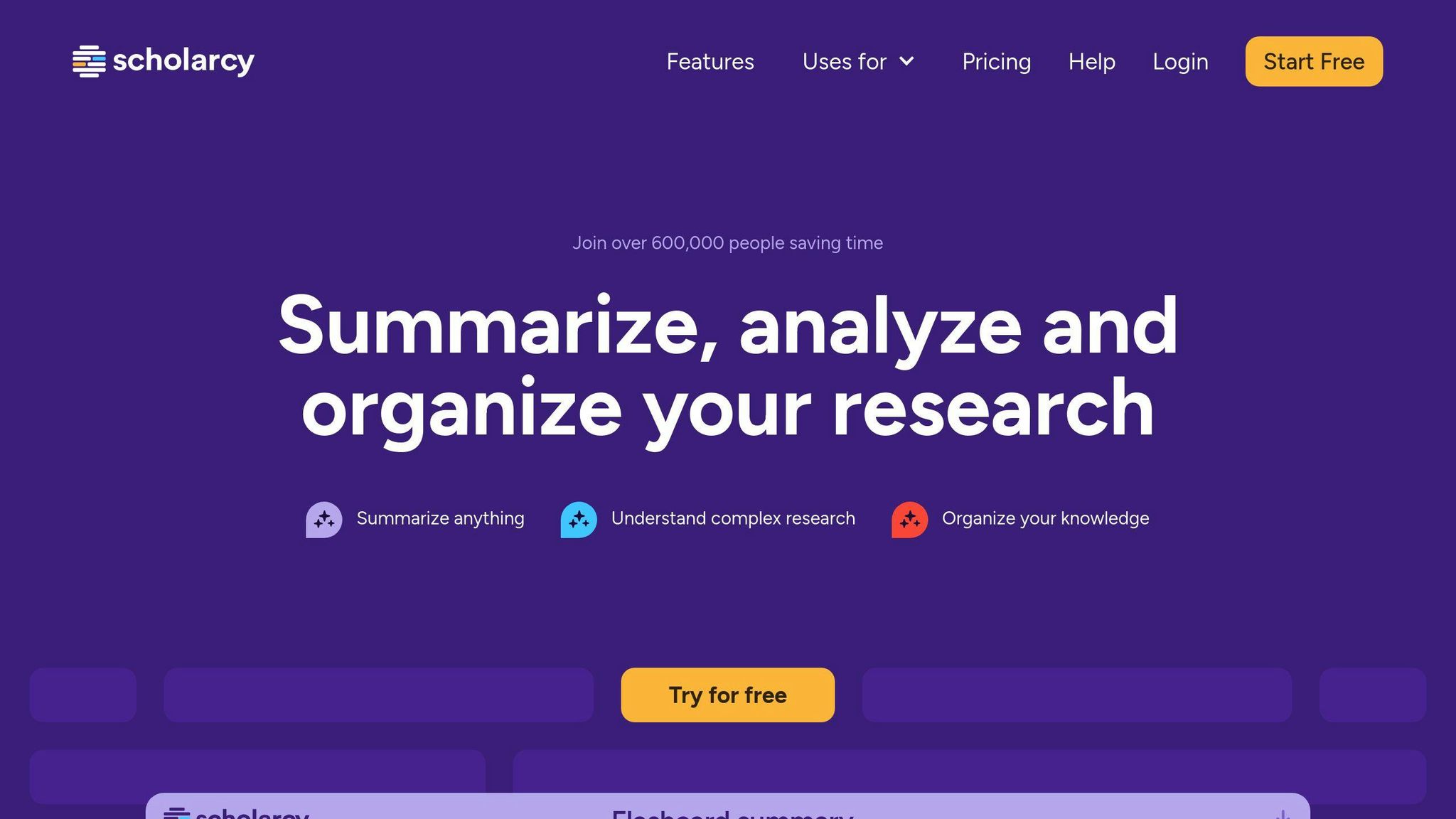
Researchers often struggle with processing large amounts of academic literature. Scholarcy simplifies this task by breaking down dense academic papers into concise, easy-to-understand summaries. Unlike tools designed for searching or mapping connections, Scholarcy focuses on simplifying complex content.
Search Capabilities
Scholarcy isn't a traditional search engine. Instead, it excels at analyzing uploaded or linked academic papers. By extracting key details, it helps researchers quickly pinpoint relevant insights without having to read the full text.
Citation Management
Managing citations manually can be time-consuming, but Scholarcy automates this process. Here’s what it offers:
| Feature | Benefit |
|---|---|
| Automated Reference Extraction | Saves time by eliminating manual citation entry |
| Accurate Citation Formatting | Reduces errors and ensures consistent styles |
| Export Compatibility | Works with major citation management tools |
Source Organization
Scholarcy helps researchers stay organized when working with multiple papers. It categorizes content systematically for better clarity:
| Component | Organization Method |
|---|---|
| Key Findings and Arguments | Highlighted and categorized based on relevance |
| Research Methodologies | Arranged by approach and implementation |
| Supporting Evidence | Grouped by type and relationship |
Summarization Features
What sets Scholarcy apart is its ability to create structured summaries. It breaks down papers into sections like methods, results, and conclusions, making complex content easier to navigate. The tool extracts and organizes main arguments, research methods, results, and conclusions into clear summaries.
"Scholarcy's ability to save time and improve comprehension is widely acknowledged by researchers. Its integration into existing research workflows helps streamline the literature review process, improving the quality of research outputs".
Comparison of Features
Analyzing the top AI tools for literature reviews this year reveals how they stack up in key areas. Here's a breakdown to help researchers pick the right one for their needs:
| Tool | Key Features | Source Organization | Best For |
|---|---|---|---|
| Sourcely | Advanced search with filters; automated citations | PDF management; reference tracking | • Quick access to credible sources with citation tools |
| Consensus | Evidence-based search in specialized fields | Topic-based categorization | • Validating findings in areas like medicine, economics, and social policy |
| Research Rabbit | Network-based discovery; co-authorship tracking | Visual relationship mapping | • Exploring research networks and uncovering unseen links |
| ChatPDF | Conversational document analysis | Document-level organization | • Quickly understanding individual papers |
| Iris.ai | Cross-disciplinary search; algorithmic summaries | AI-powered categorization | • Spotting interdisciplinary research connections |
| Scholarcy | Automated reference extraction | Systematic content organization | • Simplifying complex academic content |
Research Rabbit stands out with its network visualization, helping users discover hidden relationships between studies. Iris.ai, on the other hand, is ideal for bridging gaps across disciplines. Meanwhile, Consensus focuses on delivering research-backed insights in specialized fields, making it especially useful for areas like economics and medicine.
Matching tools to specific research needs can simplify the process:
| Research Need | Recommended Tool | Key Advantage |
|---|---|---|
| Quick Literature Overview | ChatPDF | Simplifies document understanding through conversation |
| Cross-Disciplinary Research | Iris.ai | Highlights interdisciplinary connections efficiently |
| Academic Writing Support | Scholarcy | Extracts references and organizes content effectively |
| Specialized Field Research | Consensus | Validates findings in niche domains |
For breaking down dense academic papers, Scholarcy is a great choice, while ChatPDF offers an interactive way to grasp document details. Sourcely, with its balance of academic precision and ease of use, is particularly helpful for students and early-career researchers.
"The integration of AI-powered tools like Consensus and Iris.ai into existing research workflows helps streamline the literature review process, improving the quality of research outputs".
Final Thoughts
AI-driven literature review tools bring powerful features to simplify academic research, with each tool offering unique strengths. Using these tools thoughtfully can help researchers tackle various challenges in the literature review process.
Sourcely stands out for its massive database and automated summarization, making it a great choice for students and early-career researchers. Its user-friendly search system, designed for academic needs, ensures quick and effective source discovery.
The rise of tools like Consensus highlights how AI can efficiently summarize scholarly agreement. This tool is particularly useful in niche fields, saving researchers valuable time by presenting clear, synthesized insights.
For interdisciplinary research, Iris.ai and Research Rabbit bring distinct advantages. Iris.ai helps uncover connections across different fields, while Research Rabbit’s tailored recommendations reveal hidden links between studies. Together, they showcase how AI is transforming cross-disciplinary and network-based research.
"The integration of AI tools into existing research workflows helps streamline the literature review process, improving the quality of research outputs while reducing the time spent on manual tasks".
Here’s a quick guide to match your research goals with the right tool:
| Research Goal | Best Tool | Key Advantage |
|---|---|---|
| Rapid Literature Discovery | Sourcely | Quick access to relevant sources and summaries |
| Evidence Validation | Consensus | Clear, synthesized views in specialized areas |
| Network Analysis | Research Rabbit | Explore relationships between studies dynamically |
| Cross-disciplinary Research | Iris.ai | Automatically identify links across disciplines |